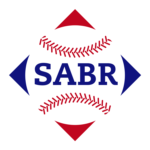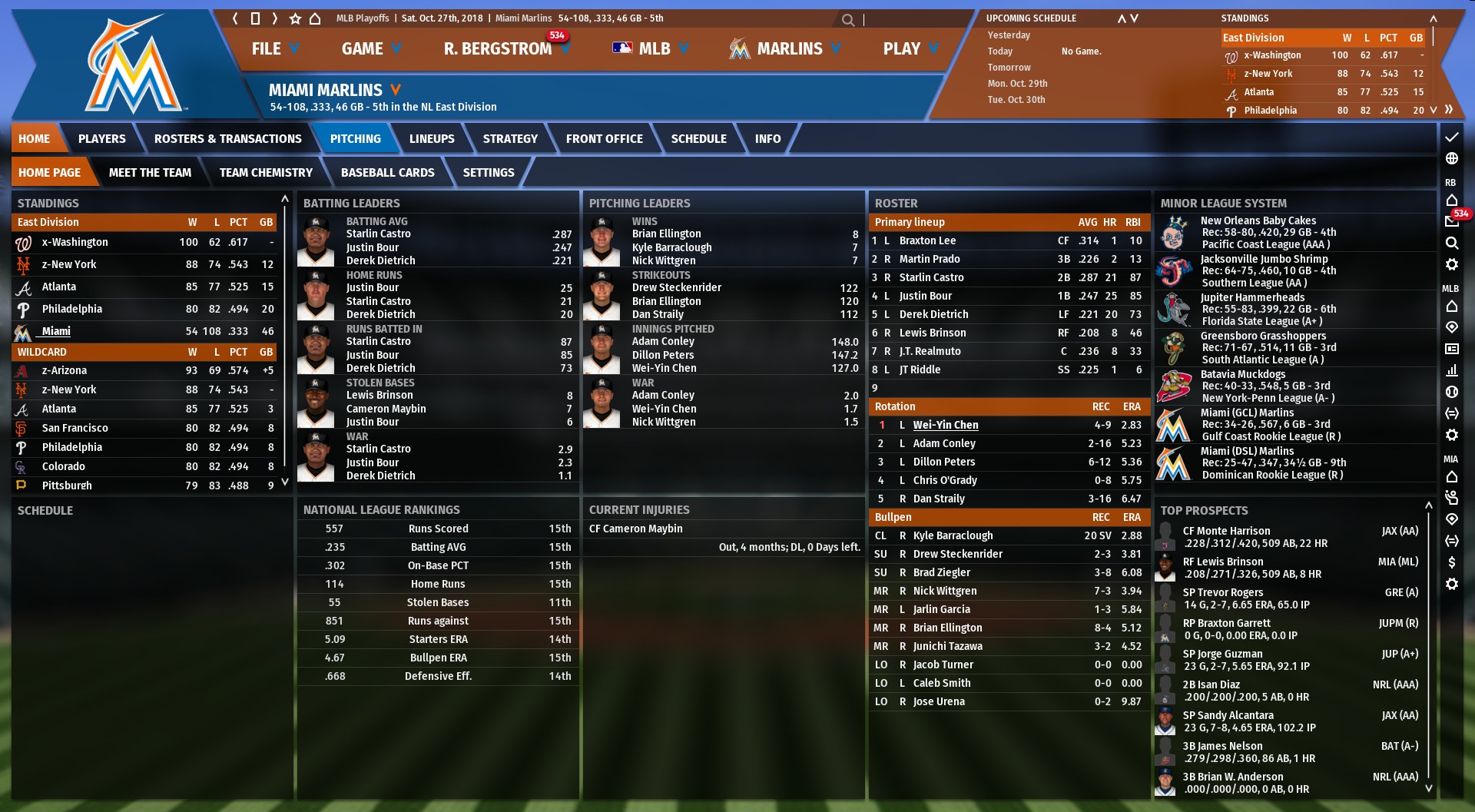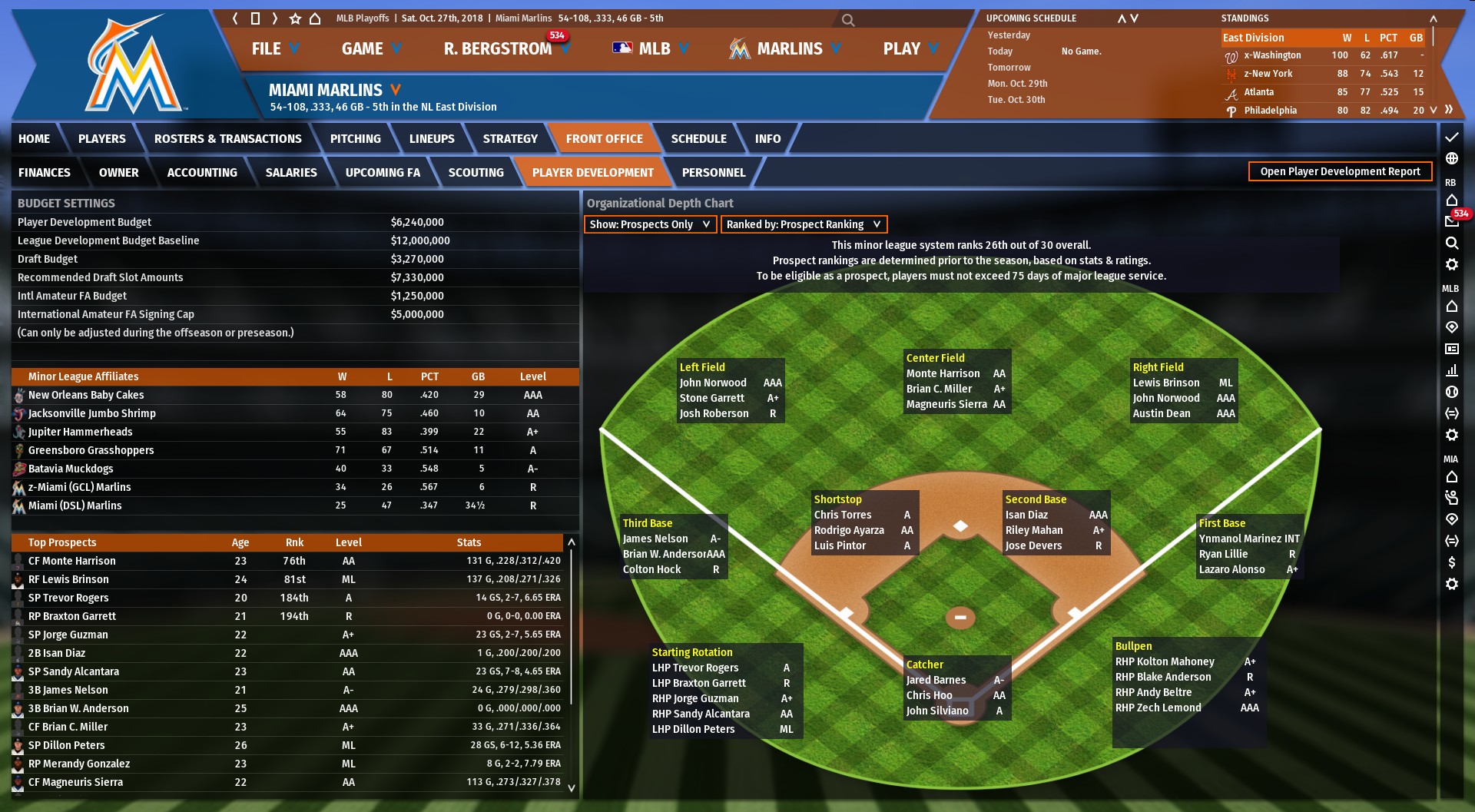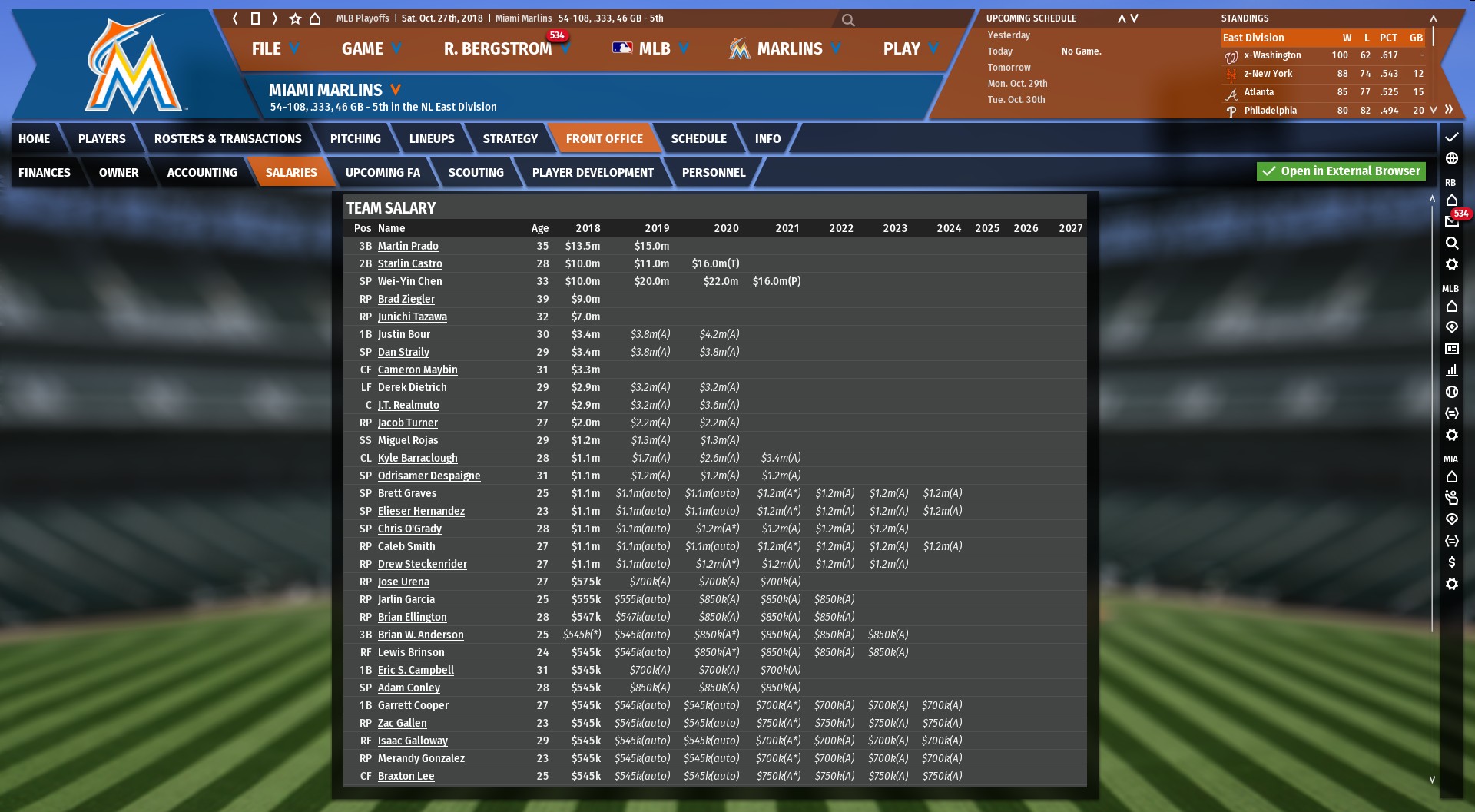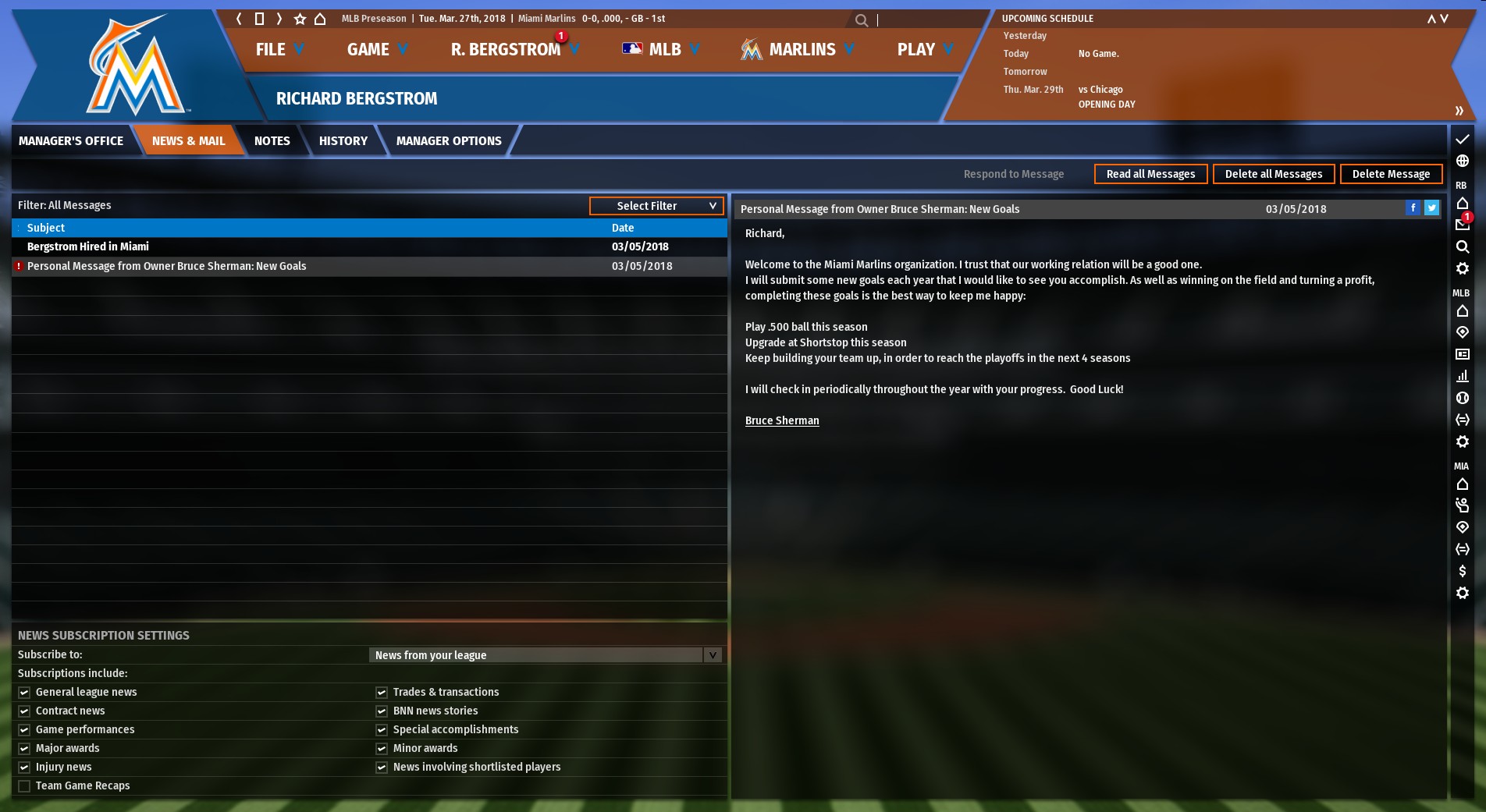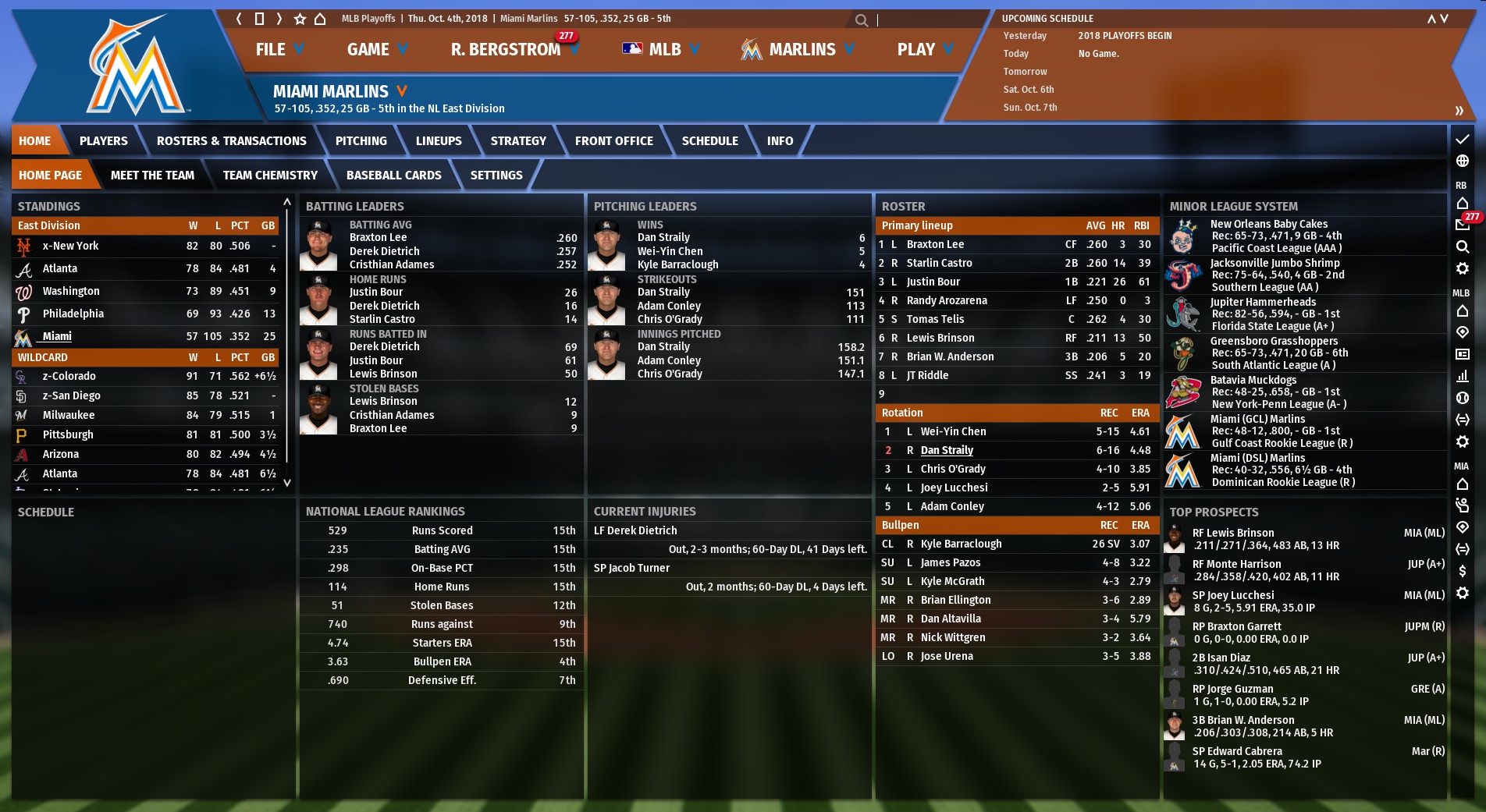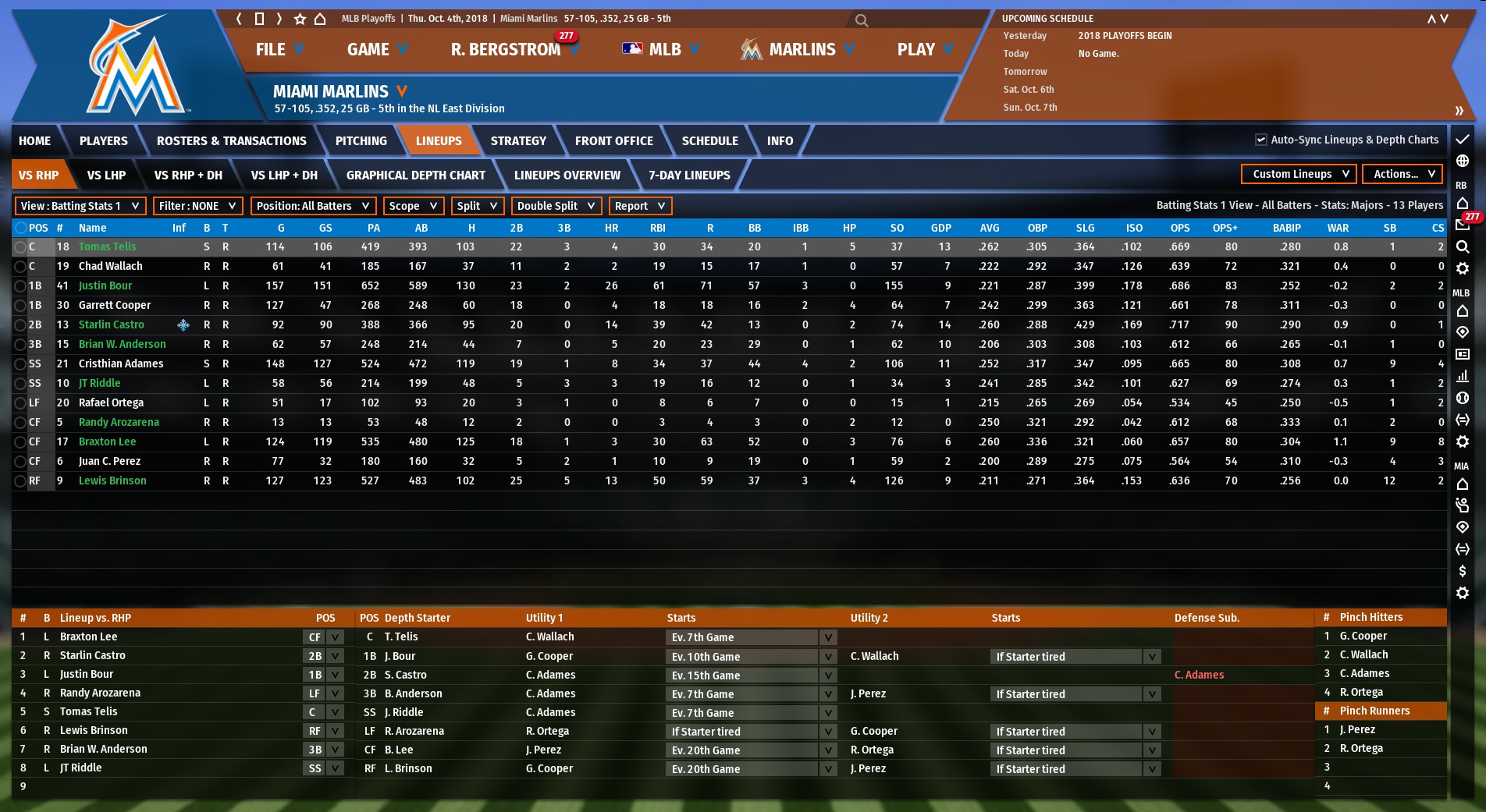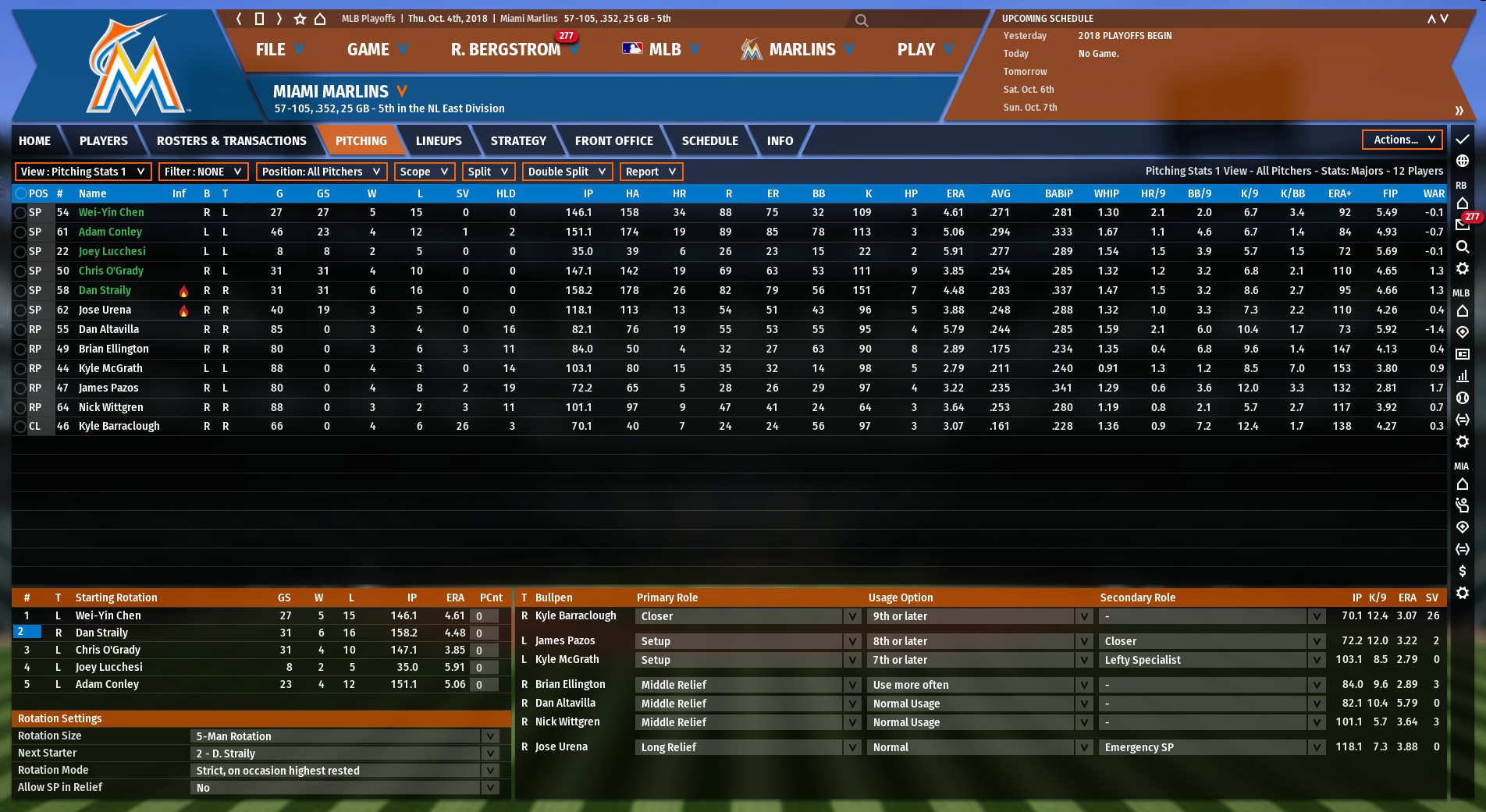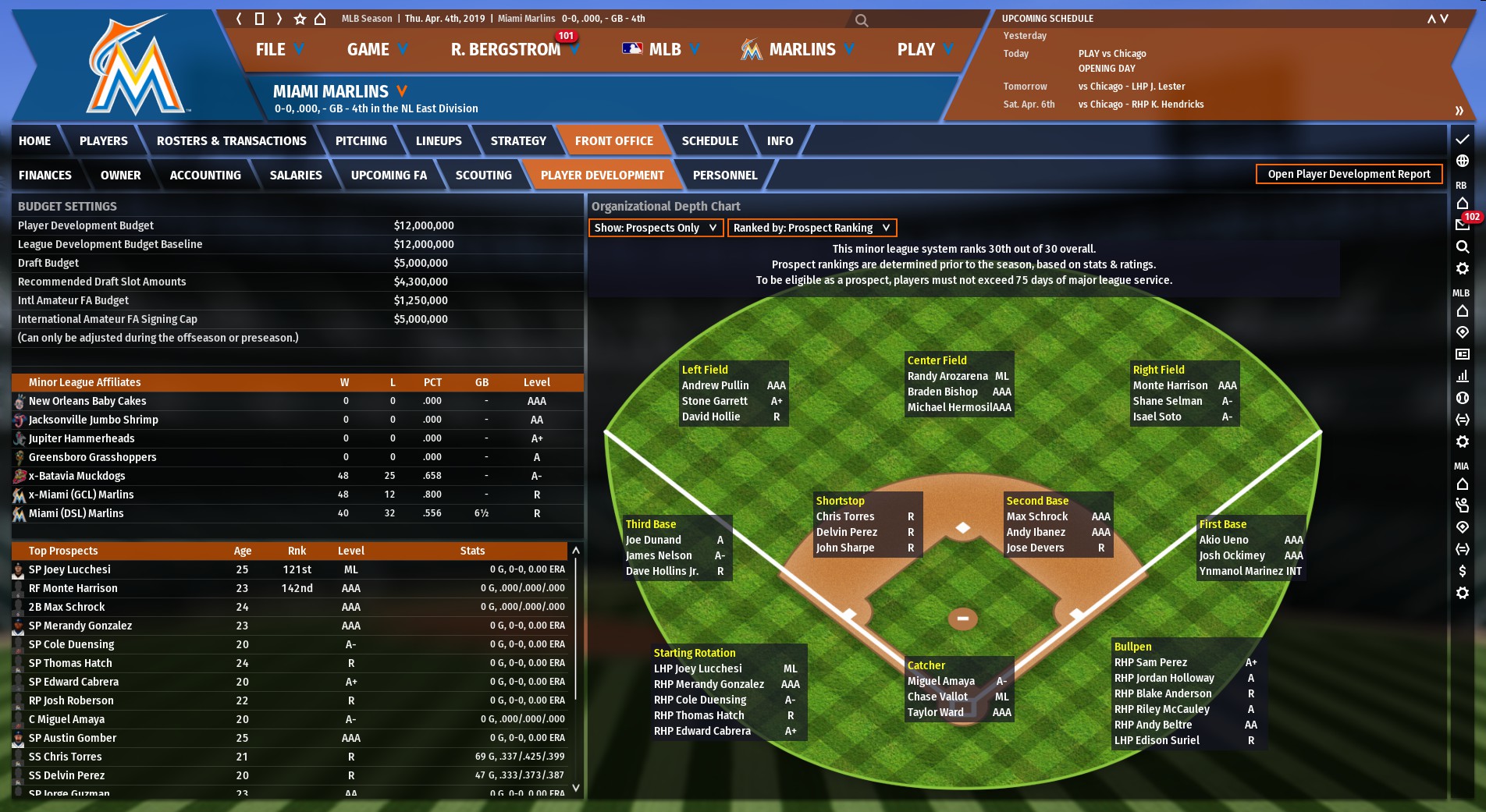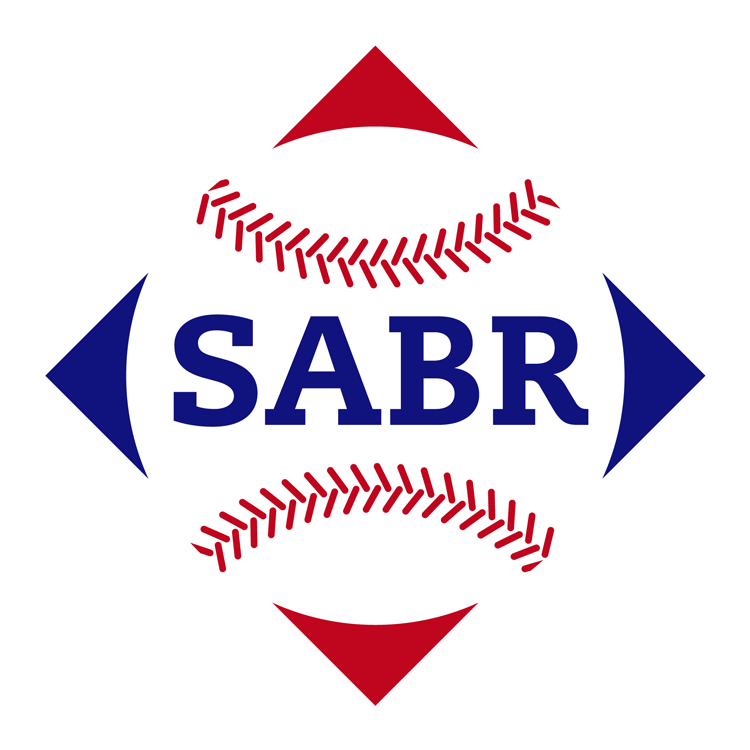Well, it’s a new baseball season which also means a new version of Out Of The Park Baseball (OOTP) to enjoy. I’ve been playing OOTP since version 6 came out and it’s fun to see that the game is now available on Steam as well as their mobile app MLB Manager on iOS and Android. Each year, I’ve either written articles on OOTP and/or had articles about OOTP featured on my Rockies Zingers site. The nice thing about a venue like the SABR Games and Simulations Committee and this blog in particular is now I can write multiple times. So I figured I’d do something a little different this year for this blog. I want to see how fast I can make the Miami Marlins good. I want to see how fast I can get them to the playoffs, even if it’s via the Wild Card. After all, it’ll probably happen faster in a game than in real life, so why not?
Thus, the Marlins Playoff Challenge begins.
This will be in spite of chilly ownership and a deservedly fickle fanbase. For the record, this will also be the first season of the first playthrough using OOTP19 so I know nothing about how any of the players or organizations “play live”. After I get through this playthrough (or get fired, since that can happen in OOTP), I’ll try to see if I can turn around the team in fewer seasons. It should be fun and hopefully you’ll enjoy the writing, if not the team itself!
If you’re up for the Marlins Playoff Challenge, feel free to give it a try yourself and report how fast you can get to the playoffs to sabrbaseballgaming@gmail.com
Generally, before I play a team, I simulate a single season a few times to get an idea of how the roster behaves. I know I just said “I know nothing” and this is how I get to know a little something. There’s too much going on to get the nuance of every player, even within one organization, but I can get an idea of the trends. Though many players perform in line with their real life counterparts, you’ll often find a few people who either surpass expectations or fail them miserably. Some might consider this a form of cheating, and I can buy that argument. I try to think of it as if I was joining a real-life front office, they would already have personnel files with histories built up on each of their players and prospects. Simulating a season while doing nothing, in itself, can take 30-45 minutes, so it can be time consuming to repeat it too much. Generally, what I’m trying to accomplish with a particular playthrough determines how much I will simulate. If I want a baseline for a team’s true talent and want to be precise in terms of “This is a 72 win team plus or minus a few games), I might simulate the inaugural season five times. Here, I just want a taste of the players and a general plan on what I want/need to do, so I’ll just be doing two full season simulations before I begin the playthrough.
With these Marlins, though, misery abounds. The first season simulation yielded a record of 54-108. Yuck. The second simulation went 51-111. More yuck. Below are some screenshots after the first season simulation to give you an idea of how the team looks.
The team was 14th or 15th in the National League in virtually every category except for stolen bases. Only one lineup regular hit better than .250, the twice-dumped Starlin Castro. No one gets on base. Defensively, the team is about average, but Cameron Maybin was a well-paid sieve in center field. Martin Prado, the highest paid player on offense at $28.5 million over two years, was a liability on offense and defense. The bright spots on offense were Braxton Lee, providing better defense than Maybin at a fraction of the cost while showing off some on-base skills in half a season of work, Castro, Justin Bour and Derek Dietrich.
On the pitching side, Wei-Yin Chen put in a decent half season but the rest of the rotation and bullpen aside from Kyle Barraclough was bad and most of them were old. Even Nick Wittgren was suspect as he barely struck out six batters per nine innings with a WHIP around 1.50. That’s generally not sustainable.
The Marlins Triple-A, Double A and single A teams all had sub-.500 records and the system was ranked 26th in baseball. Their 8th prospect was the only hitting prospect to hit above .250 and he still had a sub-par .300 OBP… in A- ball. The scary part is, by position, the Marlins system is actually top-heavy, with their best hitting “prospects” in Double-A or higher. Even then, only one hit above .250 (James Nelson), did it down in A- ball and didn’t even break a .300 OBP. To add in further fear, the major league positions with the biggest holes, shortstop and catcher, had no prospects above AA ball and even those listed, such as Chris Torres and Jared Barnes weren’t particularly good. Their second highest starting rotation prospect, Braxton Garrett, is actually a reliever.
There isn’t a single four star player in the entire Marlins organization, much less a five star. Not in the minors, not in the majors, nowhere. Castro tops the bunch at three and a half stars. Worse, there aren’t even many interesting role players that could mature into something useful besides Braxton Lee. Lee, for example, has no power and though he plays a good center field defense at a rating of 65 (out of 80), he’s not elite. I mean, if your top prospect, Monte Harrison, can’t hit .230 at AA at age 23 nor play a good center field defense, you’ve got a pretty flat talented team. I couldn’t even find platoon options worth cobbling together. The one under-the-radar guy I thought could be useful was catcher Tomas Telis, who had a 70 glove to go with mediocre contact skills and gap power. I figured he could produce as well as Realmuto for pennies on the dollar.
The only real advantage the Marlins have is they don’t have many long contracts. In my initial planning, I thought it best to clear out everyone making more than $1.5 million except for Castro, Chen, Bour, Strailly and Dietrich. Even though Castro is the second most expensive hitter on the team, he had flexibility to play some shortstop and third base and he performed well in both season simulations I ran. I was very leery of Chen’s spike in salary for 2019 but he performed well in both simulations and I wasn’t sure if I could get better for cheaper. Justin Bour was fine on offense in both seasons and had a good, if not great glove, so I was happy there. Though Straily was weak in this simulation, he was fine in the other one and $3.4 million with arbitration years coming was a satisfactory price for someone who should be an MLB average starter. I needed to keep some major league depth around. Dietrich was an easy keep, with a useful bat in both simulations and an above average glove at second base, third base and left field. I figured he could play third if I couldn’t find someone to replace Prado and prospect Brian Anderson wasn’t up to task. If not, he was fine in left field.
I love Brad Ziegler on Twitter, but not for $9 million in front of a mediocre defense.
Marlins Playoff Challenge – Take 1 Season 1
So, I restarted OOTP and began my “official run.” In my mind, the part of Marlins owner Bruce Sherman was played by Derek Jeter with the same stoicism as his Visa/Mastercard commercial.
I don’t think getting .500 will happen in the first year, though I’ve lucked into turning around bad teams before in a single year. Then again, these are the Marlins, so who knows how long the ownership will wait.
My plan was to let Prado and J.T. Realmuto go, scrape out a lot of salary to give me some flexibility for the next free agent season, and get some defensive upgrades which should improve the pitching staff overall. Realmuto just didn’t hit much in either simulated season, putting up .230ish empty batting averages and his defense was generic. Based on my experience, defensive ratings for a catcher really helps a pitching staff. So I figured I could either use Telis, or get a cheap defensive catcher and flip Realmuto for something that would be valuable down the road. I’d also rebuild the bullpen with an emphasis on strikeout pitchers and try to pick up a bevy of young two-star rated starters, one of whom might break out to be an ace. If a starting pitcher came along, I’d be interested, even if I had to pay a bit. I really wasn’t sure what I was going to do at shortstop, but I should be able to find something better than J.T. Riddle, right?…
However, there were two things that hindered this plan. First is that the first season of an OOTP season starts by default after spring training ends. Because of this, the talent available in free agency, whether free or well-paid, was very thin. The top player is Trevor Rosenthal who is injured. The only interesting person is Brett Lawrie, who I think can provide better production and defense than Prado, for just a $4.5 million contract over three years. Secondly, a number of players such as Chen, Realmuto and Prado, began the season injured. In the case of Chen, that meant my team would be short a regular starter. In terms of Prado, I couldn’t trade him until he was healthy. Since salaries and budget room gets set in the offseason and the AI behind the computer managers play most of the teams close to the red line, that means it’d be hard for me to do a salary dump. I’d likely have to find a team that’s not just interested in my overpriced vets, but can afford to take on the contracts.
As an addendum, generally I try not to power-game OOTP too much. If you want to spend a ton of time, you can min-max things in such a way that you can pull off completely “unbaseball” transactions. The trading engine is much better in recent years, where you can’t just acquire a Carlos Correa for a bunch of half star scrubs, but you can stretch the border of realistic baseball trades a bit. So generally when I play, I try to keep the trades baseball-real as in semi-fair.
One of first trades I did was also one of my best one. Thanks to the Seattle Mariners, I acquired relievers James Pezos, Dan Altavilla, outfielder Braden Bishop and two other pitchers for first baseman prospect Eric Campbell, starting pitcher Trevor Rogers and a Dominican Summer League prospect. Pezos was just the high leverage strikeout reliever I needed, available at the league minimum salary and left handed. Altavilla wasn’t quite as good, but was someone who would make a strong middle reliever with a similarly high strikeout rate coupled with a bit of a mediocre walk rate. I liked Campbell, but I didn’t love him. I had Bour around and it is generally easy to find first baseman who can hit so I was fine with letting Campbell go to strengthen my bullpen.
I dispatched Brad Ziegler and his $9 million to the St. Louis Cardinals along with two catchers and a reliever for a package of five one-to-two star prospects centered around Randy Arozarena who profiled as a mild contact hitter with elite left field defense to go with decent defense at second base and center field. My plan for him was to develop a bit at Triple A and become my super sub outfielder at worse and a useful regular at best. I wasn’t expecting Yoan Moncada for “The Unicorn”, but was happy to add some overall organizational depth and save cash at the same time.
Once Realmuto and Prado were healthy, on April 16th, 2018 (in game, not in real life), I traded them to the Boston Red Sox along with Drew Steckenrider (who was eating cheetoes for $1.1 million), Junichiro Tazawa (who was importing cheetoes for another $7 million) and toss-in reliever Dakota Bennett for ace Rick Porcello, first baseman Sam Travis, and right fielders Tyler Dearden and Tyler Espin. Porcello was making $21 million and I was sending the Red Sox $24.5 million in 2018 alone. Porcello was also owed $21 million for 2019 so if he broke horribly, I could get out of the contract easily. I also got some extra depth at first base and in the outfield, giving up a bunch of guys who, with the exception of Steckenrider, that I wasn’t going to use. Trading Steckenrider “hurt” more than the other guys, since he had been productive in my two simulated seasons.However, he started the year giving up nine walks in nine innings and struck out just three batters which sometimes mean a player in OOTP “broke” as in got old or hurt or just isn’t going to perform well anymore. But I knew I wouldn’t find another deal that would consolidate so much floatsam into something useful and I figured I could grab another righty reliever from somewhere.
My team was a hair above .400 at the end of May, much better than the .320ish win-loss percentage that ran the simulations. I was happy. It turns out, Rick Porcello wasn’t happy. After just a a month and a half’s worth of starts where he produced 1.1 WAR over just 43 innings, he demanded a trade to a winner. Welcome to Out of the Park Baseball.
I couldn’t keep him since his attitude would affect his performance and since he was taking up a third of my payroll, I couldn’t afford that. Meanwhile, other teams were already locked in on their salaries. The only taker I could find were those “Win now!” St. Louis Cardinals. Nor would it be a straight up trade. The Cardinals took a bite out of my organizational depth by grabbing three minor league pitchers on top of Porcello centered around starter Dillon Peters. I grabbed second baseman Max Schrock who reminded me of D.J. LeMahieu. Schrock had a 55 contact rating with a potential for 70 at just age 24 with good glove skills though almost no power. I also got a few rookie league one star players who might be interesting. Still, I would’ve rather kept Porcello who would’ve given me a better chance of reaching that .500 goal that Marlins owner Bruce “Jeter” Sherman gave me.
The deathknell for these Marlins came in mid-July. On July 16, 2018, I get a mail that my prized big budget free agent, Brett Lawrie, was apparently keeping his $1.5 million in cheetos to himself and thus, became a clubhouse cancer. He was hitting .251/.308/.401 which made him an offensive star on this team but not irreplaceable. In disgust at all the cheeto hoarding, I traded him off to the Texas Ranger along with a package of four semi-competent but still older non-prospects for prospect second baseman Derwin Baretto, second baseman Andy Ibanez and three other dice rolls. Baretto, at just 18 years of old, became the first four-plus star prospect the Marlins acquired, able to pick it with the glove at second and short and a solid if not spectacular bat with plenty of time to grow more. But the trade also took yet another hit on my upper level depth and sunk the Marlins’ chances of getting back to .400. Ibanez became yet another good hitting second baseman in my organization that I wished could play shortstop.
The team’s pitching was doing fine, overall. My reworked bullpen on a budget was performing good and the starters were “gamers”, giving 5-6 inning starts at anywhere from a 4.00 to 5.00 ERA. Chen was leading the league in home runs allowed but a 2.0 BB/9 and just over a hit per nine innings for a WHIP of 1.30 can work. The offense, though, was horrible. Absolutely no offense after the third spot in the order once Lawrie left. Braxton Lee, Starlin Castro and Derek Dietrich (manning left field) did their jobs, but all Justin Bour did was hit home runs. After him in the cleanup slot, it was empty batting averages led by the likes of Lewis Brinson and J.T. Riddle. Riddle got so bad, hitting below .200 with no extra base hits or walks, that Cristhian Adames was an offensive and defensive upgrade! His handful of doubles somehow added up. granted, my non-hitting catchers weren’t supposed to hit and I was ok with Tomas Telis because of his 70 glove rating. But getting no production from right field, then being forced to promote Brian W. Anderson who hadn’t hit at all in Triple A and didn’t have good glove work to compensate led to too many issues. Toss in a midseason injury to Derek Dietrich and, well, what was a .400 team in May limped to a…
57-105… a .352 finish… Well, huh.
I guess it is technically an improvement on the previous 54 and 51 win teams from the simulations.
Or it’s noise.
Well, probably not noise. As you can see from the league rankings, the defense and the bullpen improved (and at a fraction of the cost). Even the rotation’s ERAs are down slightly from the simulations. The prospects on the list are at least performing a bit better and the farm system’s win-loss records all improved. Still, in terms of “Owner’s Goals” i.e. finish playing near .500, improve at shortstop and make the playoffs in four years, I failed at #1 and #2 and have to squint real real hard for #3.
Bour. .287 OBP. How boring. (Yeah, I had to throw that one in.) Braxton led the team in OBP at .336 because Dietrich was hurt. Adames, who was the only player to go hitless for the 2017 real-life Colorado Rockies, had an OPS that was 38 points higher than Riddle’s and was almost as good as the team’s “star” first baesman. There’s your problem. Note that only Lee (and Dietrich) would have above 1 WAR for the offense. Telis’s 0.8 WAR outperformed Realmuto’s two simulated season attempts. Brinson and Anderson were zeros.
The pitching wasn’t bad though I hoped for a bit more from Chen. Being injured at the beginning of the year meant I had less time to evaluate him. I don’t think the organization was deep enough to find a replacement, but that bump up in salary to $20 million in 2019 is going to hurt… the bullpen was very solid though with only Wittgren’s K rate and Altavilla’s walk rate looking shaky. But overall, it’s an effective and very cheap bullpen.
I didn’t do the depth chart until the next season, hence all the zeroes. Still, it’s depressing to be rated 30th out of 30 in something. The lack of depth at shortstop with little budget room to hire someone and little to trade for someone is an issue… or Anderson needs to learn how to hit quickly. I may have to move Dietrich over there at some point once I find a real left fielder.
So, in terms of win-loss record, I sure didn’t seem to do all that much. I think the foundation of the team is better than what was originally there. Only playing through the next few seasons (or getting fired) will tell for certain. I remember thinking I might have cared too much about getting rid of Prado and Realmuto, especially since Porcello turned tail and ran so quickly, but I think I’ll really need the salary room in case ownership does some weird budget cutting. Also, with all the bullpen work and all the attention I put towards coming up with something, anything that might work for offense, the offense still isn’t working and at some point, I’ll need a young ace starter to hold the fort for half a decade… and I don’t have that yet.
One thing I can say is, of all the OOTP I’ve played, this has to be one of the more depressing, uninteresting teams I’ve ever played. Sure, I’ve played organizations that were totally bereft of major league talent but they still had something interesting in the minors, either in terms of hot prospects or quality roleplayers that are fun to mold into a functioning team. Those were teams where I could cobble together solutions that resemble competency. But right now, these Marlins are having problems even staffing a league average outfield, much less a league average offense. If their main option gets injured, the next person in line has probably the same poor skill set, only a little more poor.
Another thing I can say is I wasn’t fired. That means I’ve graduated the Ozzie Guillen and Joe Girardi division. Next up is Jim Leyland. Let’s see if I can survive two!
As always, feel free to leave comments and suggestions either via email or the comment section below.
Lorem ipsum dolor sit amet, consectetur adipiscing elit, sed do eiusmod tempor incididunt ut labore et dolore magna aliqua. Ac turpis egestas sed tempus urna et. Cras pulvinar mattis nunc sed. Ipsum a arcu cursus vitae congue mauris rhoncus. Tincidunt lobortis feugiat vivamus at augue. Sit amet consectetur adipiscing elit duis tristique sollicitudin. Massa sapien faucibus et molestie ac feugiat sed lectus vestibulum. Duis at consectetur lorem donec massa sapien. Duis at tellus at urna condimentum mattis pellentesque. Id donec ultrices tincidunt arcu non sodales neque sodales. Id aliquet lectus proin nibh nisl. Rhoncus mattis rhoncus urna neque viverra.
-
Joe Adonahttps://sabrbaseballgaming.com/author/joeadona_awcfg2/
-
Joe Adonahttps://sabrbaseballgaming.com/author/joeadona_awcfg2/
-
Joe Adonahttps://sabrbaseballgaming.com/author/joeadona_awcfg2/
-
Joe Adonahttps://sabrbaseballgaming.com/author/joeadona_awcfg2/
